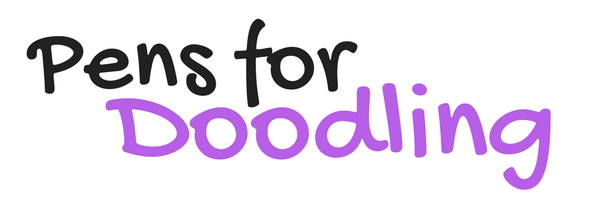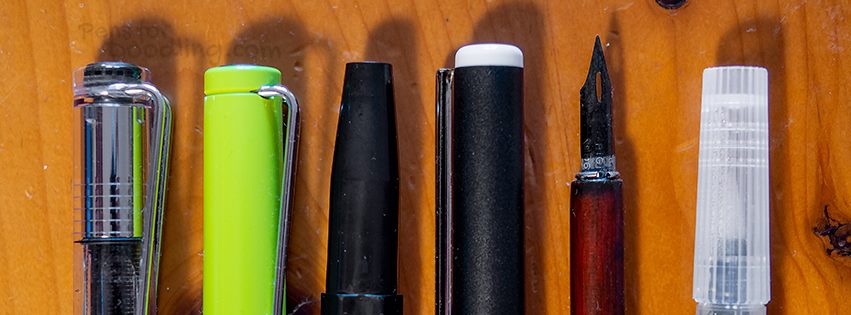How to Draw in Pen and Ink
If you want to learn how to draw in pen and ink, you’ve come to the right place. In this free course, I’ll be teaching you how to start drawing with pens. I hope you’ll learn to love ink so much that you’ll find yourself doodling everywhere.
In this lesson I’ll be looking at the most common types of pen used for doodling, sketching, and drawing so that you can think about which ones you’d like to try.
By the end of it, you should feel confident that you can select the right tool to get started!
Different Types of Pens
You’d be amazed at the range of pens that are available to you as a pen and ink artist. I’ll briefly introduce you the different types before talking about each one in more detail. That way you can get a feel for which one offers a style you’d like to explore.
At the cheapest end of the range are ballpoint pens. You shouldn’t dismiss these because of their price. They make excellent drawing tools, with practice and they’re available everywhere.
Dip pen nibs are also extremely inexpensive and are an ideal way to explore the different ways that ink can be used. You’ll need at least one bottle of ink to make use of them though.
Next in the price range come disposable drawing pens that offer a precise drawing experience, available in a range of precision nib sizes. They come pre-filled with ink, rather like a ballpoint pen but once that ink runs out, they need to be thrown away. Not ideal if you’re at all concerned with the environmental impact of your art.
At the highest end of the range are fountain pens and refillable technical drawing pens. Both of these types of pens can be refilled, either with cartridges or from bottles of ink. Although they’re more expensive, you can use them for years which makes them a much friendlier drawing tool for the environment (and will probably save you money in the long run).
Ballpoint Pens
It’s very unlikely that you haven’t already used a ballpoint pen. They’re everywhere! They’re often given away as promotional items.
They come pre-filled with ink, often pigment dissolved in benzyl alcohol, that flows through a tube until it meets the ball in the nib of the pen. As you write, the ball rotates, leaving an even distribution of ink from its surface.
The beauty of the ballpoint pen is that you can vary the pressure as you draw, leaving a very faint line or a much darker line as you increase the pressure. This offers a great deal of flexibility when you’re shading your drawings. I find this quality useful for lightly sketching an idea before laying down much heavier lines.
Because of the disposable nature of the pens, you will want to buy more than one at a time – the last thing you want, when working on a piece is to run out of ink half-way through.
Although you can buy ballpoints almost anywhere, there’s no guarantee that you’d find the same brand and I’ve found that the black ink from one brand does not look like the black ink of another!
Dip pens
Dip pens are basically a metal nib that is fitted into a ‘holder’ or handle. The range of nibs that are available is staggering. There are nibs that produce super-fine lines, others that produce broad strokes and then there are the more specialist nibs that are intended for calligraphy (I wouldn’t recommend drawing with those).
As well as the actual stroke size the nib produces, the other quality different nibs offer is flex. Some nibs have a certain amount of flexibility in them so if you press harder, the line you produce becomes wider. This can produce very dynamic and interesting line work.
The handles that they slot into are available in many materials including plastic, metal and wood.
The beauty of dip pens is that you can use them with any ink you have available. As the name suggests, you draw by dipping the nib into the ink before drawing with it.
As there’s no ink cartridge, you’ll need to keep dipping the nib into the ink as you work (practice will teach you how often as it varies from nib to nib. Some nibs have a little well or bowl in them to hold a small amount of ink to work with).
You will need a separate bottle of ink to use and there is an endless array of colors and properties to choose from. Some are permanent, most are water-soluble and some are designed to be exceptionally dark.
Disposable Drawing Pens
Drawing pens are wonderful tools. They’re not as readily available as the humble ballpoint but they’re still easy to get hold of. They offer nibs in a variety of sizes (from as little as 0.05mm) with each one producing lines of a very consistent width.
Unfortunately there’s no standardization in the numbers used to denote tip size so the size 0.1 from one pen brand won’t necessarily be the same as another.
You don’t get any line variation with a disposable drawing pen but you do get the piece of mind of knowing all your lines are going to be the same width but there’s a catch. As the pen tip becomes worn, the line widths might become gradually wider (depending upon how heavy-handed you are).
Just like ballpoint pens, once you find a point size that you like, don’t just buy one. Because they’re disposable, they will run out of ink, often in the middle of a piece of artwork.
Technical Drawing Pens
Technical drawing pens are very similar to disposable drawing pens but instead of have a fine tip of plastic or compact fiber, they use a fine wire mounted in a steel tube. The finer pens do require a more delicate hand as the fine wire could easily be damaged (so don’t drop them on the floor with the cap off).
Because technical drawing pens are intended to be used for professional work, their nib sizes are indicated in millimeters and they should produce a line in that width. The lines from a technical drawing pen should be consistent and smooth but there is no opportunity to vary the line width when drawing.
Technical drawing pens are designed to be refillable, either with disposable ink cartridges or with a special chamber that can be filled with ink. You do need to be careful to only use the recommended inks as they can easily become blocked.
With careful use and maintenance (e.g. regular cleaning), a good technical drawing pen can last for years.
Fountain Pens
Fountain pens are more commonly associated with writing rather than drawing but they actually make excellent drawing tools.
They feature a metal nib, similar to those used in dip pens and are fed by an internal ink cartridge, refillable cartidge (called a converter) or a permanent ink reservoir.
Fountain pen nibs can be made from a variety of metals, including silver or gold but steel is most commonly used.
Some pens you can buy feature springier nibs so you can vary the width of the line as you draw just by pressing a little harder. Some pens enable you to vary the width by tilting the nib slightly to produce a finer line.
As with technical drawing pens, you need to be careful about the inks you use in a fountain pen as the capillary (the fine tube that feeds the ink to the nib) can become blocked by more specialist drawing inks.
What’s the best pen to draw with?
The best pen to draw with is the one in your hand.
Joking aside, this is a question that only you can answer.
Try them all out and see which feels better in your hand and more natural to draw with. Some artists I follow solely use ballpoint pens, others fountain pens and one in particular only ever uses a dip pen.
My favorite is currently my Safari Lamy, closely followed by the Platinum Carbon Desk Pen (both are fountain pens). I love drawing with all pens but those are the ones in my hand the most.
Wrap up
In this lesson I’ve introduced the different types of pens commonly used to draw with ink.
There is no better pen than the one you enjoy drawing with and you’ll soon find one that fits your style and technique.
There are detailed reviews of pens for drawing here on the website. New reviews are added regularly so check it occasionally for updates or subscribe to the newsletter!
In the next lesson, I’ll be looking at which papers are the most suitable for drawing with pen and ink.


